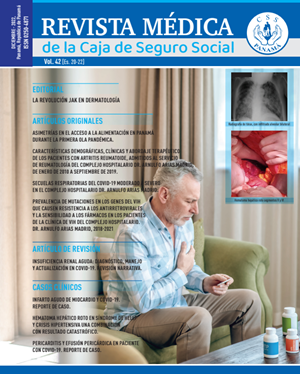Prevalence of mutations in the HIV genes that cause antiretroviral resistance and medication sensitivity in patients of the HIV Clinic of the Complejo Hospitalario Dr. Arnulfo Arias Madrid Hospital, 2018-2021
Main Article Content
Abstract
Antiretroviral treatment is the main support for the management of HIV infection and makes it possible to maintain undetectable viral load levels in the blood. In some patients, treatment fails to maintain viral load suppression, triggering resistance to treatment, caused by genetic changes in the virus that give it a genetic advantage over antiretrovirals. We carried out a non-experimental, cross-sectional and retrospective Master’s Thesis for the “Master’s degree on human immunodeficiency virus infection, 2021-2022 edition. ESTHER project. Rey Juan Carlos University and Ministry of Health. Madrid” where we studied 112 genotyping results of blood samples from HIV-positive patients in the period 2018-2021 carried out in the CHDr.AAM laboratory. We found that 85.6 % of the samples presented resistance and that 41.7 % belonged to Nucleotide Analog Reverse Transcriptase Inhibitors (NRTIs), 40 % to Non-Nucleotide Reverse Transcriptase Inhibitors (NNRTIs) and 4.1 % to protease inhibitors, integrase did not show resistance. Only 17 % of the mutations were high level, of which 75% corresponded to reverse transcriptase. The main mutations recorded were M184V (14 %), K103N (11 %), P225H (4.9 %), K65R (3.6 %), L74I (3.1 %), L100I (2.8 %), AT1V (2.55 %). We found that the antiretrovirals with the highest degree of resistance are: AZT, ABC,TDF, also FTC and 3TC within the NRTIs, in the NNRTIs NVP, EFV and DOR occupy the highest prevalence. To a lesser extent, there are protease inhibitors such as FPV/r, NFV, LPV/v.
Downloads
Article Details
Issue
Section

This work is licensed under a Creative Commons Attribution-NonCommercial 4.0 International License.
How to Cite
References
1. Organización Panamericana de la Salud, Organización Mundial de la Salud. (2017). Plan de acción mundial sobre la farmacorresistencia del VIH (2018- 2021). OMS Depto. VIH-SIDA. Ginebra- Suiza.
2. Organización Panamericana de la Salud, Organización Mundial de la Salud. (2017). Directrices sobre la respuesta de salud pública a la farmacorresistencia del VIH previa al tratamiento. OMS, Depto. VIH-SIDA. Ginebra- Suiza.
3. OPS/OMS, (2012). Tratamiento antirretroviral bajo la lupa: un análisis de salud pública en Latinoamérica y el Caribe. Organización Panamericana de Salud.
4. Pascale J. Resistencia transmitida en Panamá (2012). Instituto Conmemorativo Gorgas de Estudios de la Salud. Departamento de genómica. Panamá.
5. Núñez E, Lobán A. Descripción de factores que inciden en la resistencia al VIH en pacientes de la clínica de terapia antiretroviral de Colón 2016-2017. Rev Méd Caja Seguro Soc. 2018;40:33-43.
6. Mulanovich V, Gutiérrez R. Resistencia al TARGA, Falla terapéutica y Adherencia. Instituto de Medicina Tropical Alexander Von Humboldt, Universidad Peruana Cayetano Heredia.
7. Galindo-Orregoa P, Mueses-Marína H, GalindoQuinteroa J, Martínez- Cajasa J. Resistencia transmitida del virus de la inmunodeficiencia humana en pacientes sin exposición previa a tratamiento antirretroviral, Cali, Colombia. Sociedad Colombiana de Infectolorgía, ElSevier. Infectio 2013; 17:19-27.
8. Yabar C, Vilcarino G, Espetia S, Yaya M, Salinas G, Garcia L. Resistencia transmitida en VIH-1 de pacientes provenientes de nueve departamentos del Perú. Rev Perú Med Exp Salud Publica. 2021;38:77-82.
9. Ministerio de Salud de Panamá, Caja del Seguro Social. (2011). Normas para el Manejo Terapéutico de las Personas con VIH en la República de Panamá.
10. Department of Health and Human Services, USA (2021). Guidelines for the Use of Antiretroviral Agents in HIV-1- Infected Adults and Adolescents. AidsInfo.
11. Cecchini D, Castillo S, Laudia Vecchio C, Sandoval C, Cabrall, Rodríguez P, Cassetti I. Resistencia primaria de VIH en el área metropolitana de Buenos Aires; Medicina Buenos Aires 2015;75:163-8.
12. Espín EA, Nuñez-Freile BF, Larreátegui DA, Luján MF, Espinel EM. Resistencia a fármacos antirretrovirales en la Clínica de VIH del Hospital de Especialidades Carlos Andrade Marín. Rev Med Cambios HCAM 2018; 17:3-9.
13. Fernández Lisón LC, Fernández Pereira LM, Romero Chala S. (2010). Tasa de mutaciones genotípicas y resistencia a antirretrovirales en un hospital general. Farmacia Hospitalaria. 2011;35:191-6.
14. Grupo de Educación en SIDA (GeSIDA) de la Sociedad Española de Enfermedades Infecciosas y Microbiología Clínica (SEIMC). (2018). Documento sobre la utilidad clínica de las resistencias a antirretrovirales.
15. Guerrero A, Cañizares A, Tomás S, Velasco D, Cartelle M. (2005). Prevalencia de resistencia a los fármacos antirretrovirales en pacientes españoles infectados por el VIH y sin tratamiento previo. Área de Diagnóstico Biológico. Hospital de La Ribera- Valencia.
16. González-González M, Correa-Sierra C, Hermida-Álava K, Machado D, Gómez-Andrade F, Castillo-Segovia M, et al. Análisis genético de mutaciones en la población infectada por VIH-1 en Ecuador. Rev Chilena Infect. 2018;35:49-6.
17. Cámara R, Arce-Humani M, Franco M, Díaz- Monge J. Resistencia a la terapia antirretroviral de primera línea. MedWave. 2017;17.
18. Stanford University. (2020). Major HIV-1 Drug Resistance Mutations. Stanford HIV drug resistance database. References: hivdb.stanford.edu/s/who.

